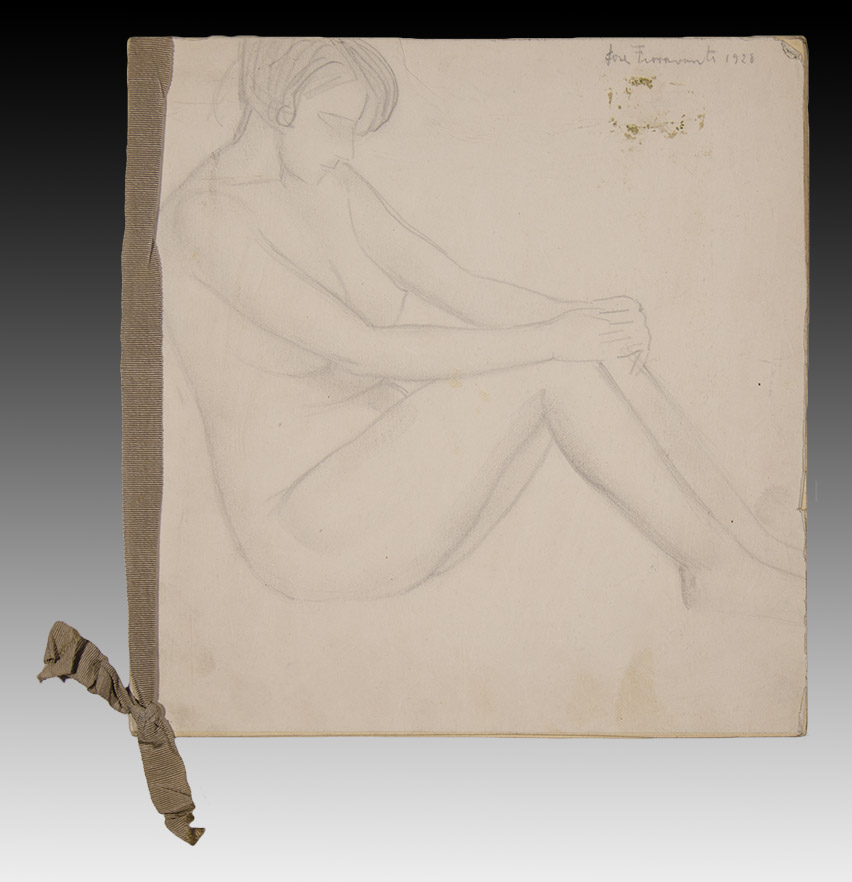BACK TO TOP
ART
Female nude. 1921.
Graphite pencil on paper, mounted on cardboard that forms a folder, with a knotted ribbon. Measurements: 25.5 x 25 cm. Signed and dated in the upper right corner. Former Alfredo González Garaño collection.
Full-length, this female nude occupies the entirety of the paper. Sitting down and with her legs slightly folded, the model takes her knees with her crossed hands. Her head is tilted and her gaze is downward, generating a closed, self-absorbed body position. The composition made in simple lines, almost without shadows or details shows us, in this early work of the brilliant Argentine sculptor, his interest in volumes. This may be a study of the body or, properly speaking, a sketch to later take to three dimensions. In short, it is a testimony to the importance of the female nude in Fioravanti's work, an issue that will run through his entire production. The work is prior to his trip to Europe, and therefore, it is not about Ludmila, the Russian artist he met in the Old World, whom he married and who became Fioravanti's great model, as we see for example in Woman with a Book, a sculpture with which she won the Acquisition Prize at the National Salon in 1937, and the gold medal at the Exposition Internationale des Arts et Techniques in Paris -now a heritage of the National Museum of Fine Arts- or in the works Ludmilla (bronze, 1929), Ludmilla (stone, 1933), Ludmilla and Mascha (1934, bronze).
José Fioravanti (Buenos Aires, 1896 - 1977), sculptor, self-taught artist, trained in the sculpture workshops of Buenos Aires. In 1919 he obtained his first prize. He traveled to Europe in 1924, where he exhibited at the Museum of Modern Art in Madrid; and two years later, at the Salon of Modern Art in Paris. In both cases they acquired one of his works. In 1927 he returned to his country but returned to Europe in 1929, settling in Paris. Upon his return, he was a direct carving teacher at the "Ernesto de la Cárcova" Higher School of Fine Arts and appointed Number Academician of the National Academy of Fine Arts in Buenos Aires. His work is present throughout the country. President Marcelo T. de Alvear commissioned him to carry out sculptural decorations in the lobby of the Casa Rosada. Soon his work would become prolific and varied. His are the Monument to Nicolás Avellaneda in Buenos Aires (1935), Kilometer Zero in Buenos Aires (1935), the Monument to Roque Sáenz Peña in Buenos Aires (1936), the Monument to the Sea Wolf on the Rambla de Mar del Plata ( 1941), the Monument to Simón Bolívar in Buenos Aires (1942), the Sculptures of the National Historical Monument to the Flag in Rosario de Santa Fe (1957, in collaboration with Alfredo Bigatti), the Monument to Fructuoso Rivera in Montevideo (1965), and the High Relief of the San Martín Theater in Buenos Aires (1962), among other examples.
| AUTHOR | JOSÉ FIORAVANTI |
|---|
Are you interested in selling some works?
Send us an email briefly indicating
which works you intend to put on sale, and we will respond. click here
Subscribe to our newsletter to be updated.
Check our Newsletters